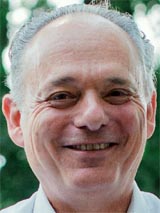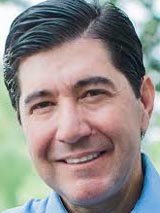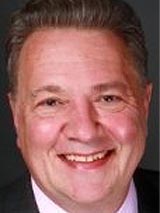Registered Democrats will be voting on Tuesday, September 13, 2016, to select three candidates from among the four seeking to represent the party in the November 8 election for the Mamaroneck Village Board of Trustees. The winners in the primary will face the three Republican candidates already chosen by their party.
In alphabetical order, the Democratic primary candidates are Leon Potok (incumbent), Victor Tafur, Stuart Tiekert and Keith Waitt. Mr. Potok, Mr. Tafur and Mr. Waitt have been endorsed by the Village of Mamaroneck Democratic Party. The LWV-LM asked the four to submit biographical information and responses to questions, which appear below.
BIOGRAPHY
| Leon Potok long served as a financial advisor to industrial labor unions in negotiations with financially distressed employers. Leon also worked for a major New York insurance company, recommending and monitoring investments. He served as chairman of the Village Budget Committee for five years and served on the Mamaroneck School District Budget/Finance Committee before becoming a Trustee in 2012. Leon holds a B.A. and M.A. in economics, as well as an M.B.A from Columbia School of Business. He has lived in the Heathcote Hill neighborhood since 1998. He and his wife have three adult children. | Victor Tafur is an environmental law practitioner that has worked for major environmental advocates in the region and is currently the Co-Director of the United Nations Environmental Diplomacy Program at Pace Law School as well as part-time faculty at Bard College’s Center for Environmental Policy. He’s lived in Mamaroneck for 12 years with this wife and daughter. | Stuart Tiekert
Education: Butler University,
Occupation: Garden Design
Resident of Mamaroneck for 30 years
Former member of Tree Committee
Former Chair of Democratic Party
|
Keith Waitt serves as Chairman of the Village Budget Committee and a member of the Village’s Industrial Advisory Committee. He’s spent his career in financial services in both London and New York. In 2007 he left a large global banking institution to set up his own integrated learning services firm that trains the financial sector in risk management and compliance. Keith and his family have lived in the area for 18 years. Born in Edinburgh, raised in Nigeria and educated in England, Keith provides a cross cultural perspective to living in an internationally diverse community such as the Village of Mamaroneck. His wife, Lorna works for a non-profit healthcare firm in Manhattan. His two sons, Tom and Josh, were educated through the Mamaroneck Schools system and now both work in New York City. |
Question 1: What are your thoughts on the Army Corps of Engineering flood control project and how do you propose to secure the funds from the State, County and local levels?
| Leon Potok: The USACE flood control project offers our Village a long-awaited, promising opportunity to deal with flooding on a large scale. The planning process is designed to include input from community members.This project is essential. I will do my best to secure approvals necessary for its implementation. The next phase: Congressional authorization to proceed with the design and construction. We will need to work with elected officials in White Plains, Albany, and Washington to secure funding, and mobilize our community to impress upon decision-makers the urgent importance of this project for our Village.As liaison to the Flood Mitigation Advisory Committee since 2012, I have seen this Committee play a critical role in exchanging information with residents and government. I have represented the Village, with Mayor Rosenblum and others, at meetings with the Army Corps of Engineers. Such dialogue facilitates the continued progress necessary to complete the project. | Victor Tafur: The Army Corps of Engineers flood mitigation project is critically important for the protection of the lives and property of all the residents. It is also necessary for the economic and environmental viability of the Village, including plans to revitalize the industrial area and the riverine residential neighborhoods in higher risk of flooding. This must be a bipartisan effort.How we —collectively— deal with flooding prevention and mitigation will define the Mamaroneck we are, believe in, and deserve. To secure funds, mobilize politically to secure the funding commitment by the federal and non-federal partners. For the Village’s share of the cost, consider the issuance of long term bonds. | Stuart Tiekert: We all want flood mitigation. But we need a trustee on the Board who will prevent any flood mitigation project from spiraling out-of-control and becoming another fiasco like the Jefferson Avenue Bridge. We need a trustee who will learn the project details and keep the work on track. We need a trustee who will be open and transparent rather than keeping the residents in the dark about plans and progress. As I did with the Jefferson Avenue Bridge project, I will learn the plans, I will listen to all perspectives, and I will challenge assertions to deliver a responsible flood mitigation project on time and on budget. We cannot afford to be lackadaisical about public infrastructure improvements. They are costly and important to our future and they need to be done right. I am the only candidate with a track record serving that need | Keith Waitt: The ACE proposal is our final and most realistic chance to implement a significant flood mitigation program for our Village in the near term. I am fully supportive of the project and aim to ensure it is expedited as fast as possible. We will need to mobilize politically at County and State level to get financial support. The most important leg of the stool will be Congressional authorization. The Village will borrow its $6 to $8 million contribution with long term borrowing. |
Question 2: What is the correct solution for parking in the Village?
| Leon Potok: As recommended by our parking consultant and non-partisan Parking Advisory Committee, raising rates to $1/hour and extending meter hours on Mamaroneck Avenue should free up short-term spots, by shifting longer-term parking to nearby, cheaper lots.“Differential pricing” is the efficient way to balance demand between the most desirable and less convenient spaces, reducing congestion on the Avenue. The Village offers hundreds of parking spaces downtown.Also, the old, often broken meters should be replaced by modern meters providing secure cash storage, ability to program rates and hours, credit card usage, and other benefits.The new multi-space meters in the parking lots have improved security and dependability, but are not user-friendly. The Board of Trustees is awaiting advice from the Parking Advisory Committee on which meters to install on the Avenue and whether to replace the multi-space meters in the lots with others. | Victor Tafur: At this stage, to avoid further confusion, continue the use of the multi-space meters in the parking lots adjacent to Mamaroneck Avenue, and the most friendly-to- use meters—as determined by the recent trial—on the Avenue. The parking problem on Avenue is “more an imbalance than a true lack of parking,” and “the imbalance is exacerbated by long-term parking along Mamaroneck Avenue by employees,” as was confirmed by the Village’s 2014 parking study. Thus, the solution involves enforcement of the parking limit and the addition of short-term parking spots for pick-ups. For other areas of the Village, in particular those near the train station, continue prudent and careful consideration of residents-only areas. | Stuart Tiekert: There are two parking issues– meters for Mamaroneck Avenue and the residential parking permit program for streets near the train station. Our residents don’t like the multi-space meters bought for Mamaroneck Avenue. We need to act promptly to put new single-space meters in place so that we have fully functioning meters.A new residential parking permit system is a great idea but its implementation has been a circus –three different versions of the “enacted” law and poorly noticed and conducted public hearings. This is no way to conduct government business.If elected, it will be my job to make reasonable parking laws and ensure fair enforcement of those laws. We need broad opportunity for the public to help tailor solutions, fair notice of parking changes, and grace periods when warnings, not fines, are issued. | Keith Waitt: It is important to begin by stressing that there is currently sufficient parking to meet our needs in the Village. The problem is threefold. Firstly, that the most popular parking requirement, on Mamaroneck Avenue, is being abused. Secondly, our meters are old and many do not work. Thirdly, parking enforcement is not consistent. Accordingly, the correct solution is three-pronged. Firstly, to marry demand and supply on the Avenue by raising prices and extending hours , while encouraging the use of cheaper parking lots. Secondly, to install meters that are modern, practical and user friendly. Thirdly, to ensure enforcement. |
Question 3: What is your vision for changes in the industrial section of the Village?
| Leon Potok: I am proud to have initiated a volunteer non-partisan Industrial Area Redevelopment Steering Committee to explore options for revitalizing this area. The Committee is moving forward with recommendations, which were developed with the assistance of a superb consulting firm retained by the Village, to revitalize the industrial area by attracting new businesses into the area, without uprooting or disrupting incumbent businesses and residents.I expect that the Committee’s proposals will reflect the needs of the surrounding community, environmental considerations, attention to aesthetics, and an aspirational view of a large new place for residents and visitors to learn, work, create, shop, seek services, and enjoy life. All of which will make the Village a better place to live and visit, and broaden our tax base to help mitigate future tax increases. | Victor Tafur: A mix of commercial and light manufacturing uses, including art-based uses with green spaces and more tree cover. A regional hub for small business from high-tech business to artisanal foods. Towards this goal, strategic planning and adequate rezoning would be necessary, taking into account public input at all planning and implementation stages. The Industrial Advisory Committee has been leading the effort in the right direction. The effort must be integrated with the flood mitigation project. | Stuart Tiekert: Our industrial area provides a wonderful potential for future development but we must be mindful of the flooding risks in that area. Our Board of Trustees has done so much flavor-of-the-month re-zoning in response to developer needs without regard to our comprehensive plan: Transit Oriented Development, Sheldrake Lofts, Aqua-tots, and re-development on Library Lane—are all examples of a piecemeal re-zoning approach to satisfy individual demands rather than a community vision.The industrial area rezoning should be different. It was contemplated by the comprehensive plan. A conscientious resident study group has been working hard to develop a vision of the industrial area and that should provide a starting point for a community vision for re-zoning this area. | Keith Waitt: I am a member of the Industrial Advisory Committee and I have been actively involved in this project. The vision is the revitalization and sustainability of the area by attracting small businesses such as food, art, recreation and retail operations into the section. To do this, we need to update the zoning laws for this area in order to attract these types of 21st Century businesses. This will take a coordinated effort of all our community to incentivize economic growth in this area while ensuring it complements our existing business district and provides environmentally-sensitive redevelopment. |
Question 4: Have we made progress in improving the health of the Long Island Sound? What needs to be done and how can those objectives be achieved?
| Leon Potok: The Village has worked hard and spent significant funds to improve the water quality in our rivers and the Sound with ongoing programs to eliminate sewer discharges into our stormwater system. The Village has undertaken a number of programs to improve the quality of water released into the Sound, such as identifying and fixing broken lateral pipes running from businesses and homes to the Village sewer lines; re-lining in place more than one-third of Village sewer pipes; cleaning and inspecting Village sewer pipes; and eliminating illicit connections of stormwater to the sanitary sewer system.We can do more to encourage environmental sensitivity in home-and-garden care, construction, energy use, marine recreation and other sources of water pollution. Our recently expanded Marine Education Center will go a long way toward educating and informing our youngest residents, their parents and the larger community of the need to protect this wonderful resource. | Victor Tafur: Long Island Sound is far from attaining the minimum “fishable and swimmable” water quality goals. Recovery is slow and severe threats remain. According to New York State’s List of Impaired Waters, the Sound’s waters are impaired due to oxygen demand (hypoxia), excess nitrogen, and pathogens. As a result of pollution from stormwater runoff and sewage—especially the Western portion of Long Island Sound including the waters in Larchmont and Mamaroneck harbors—are suffering chronic degradation in water quality, which has led to fish-kills, consumption advisories, periodic beach closures, and limited recreational uses. The Village needs to continue fixing the sewer system and enforcing the separate storm system regulations. A preventive maintenance program, with monitoring of water quality levels year-to-year, must be implemented in the Village. | Stuart Tiekert: I would like us to set goals for water quality and track progress toward measurable objectives because “what gets measured, gets done.” For example, our goal is zero illegal hookups but the Village cannot confirm that those identified in 2007 have been remediated. Similarly, our sewer lines are aged and crumbling. We should have a goal of 100 percent of our sewer lines in good condition but records on the location and condition of such lines is withheld from the public. Similarly, we need a goal of 100 percent enforcement of erosion and sediment controls at construction sites but I routinely observe violations. We don’t know all that we must do to move the needle on water quality but Save the Sound has been taking systematic measurements, allowing us to better track progress in light of investment. Dead fish washing ashore should become a thing of the past. | Keith Waitt: We should aim to hasten the pace of progress by focusing Village attention on water quality. We should better coordinate our monitoring and measuring our progress with the County and with local advocacy groups, such as Save the Sound. The Village is reviewing a revised LWRP prepared by a working group and coordinated by the Coastal Zone Management Commission. The revised proposal makes important recommendations on monitoring and improving water quality. One that I support is the creation of a Water Quality Committee. |
Question 5: Mamaroneck faces serious need for infrastructure improvements — above and below ground. What needs could you identify — and what priority would you give to attending those needs?
| Leon Potok:Above ground, Village assets must be maintained properly and replaced when they’ve outlived their useful life. Our Department of Public Works facilities are in the greatest need of replacement and/or upgrading to improve working conditions, safety and productivity.The Board has upgraded a number of parks and playgrounds in the last couple of years. There’s more to do, including restoring the former Taylor Lane compost site for public use, and developing/implementing a new Harbor Island Park Master Plan.This fall, the Village Board will evaluating a contract to overhaul much of the signage and wayfinding in the Village, based on the work and recommendations of the Wayfinding Committee. I initiated formation of the Wayfinding Committee, based on the parking consultants’ recommendation to improve central business district signage, especially regarding location of the parking lots.Below ground, the sewer and stormwater systems are old and need continual upgrading. | Victor Tafur: The Village should consider a comprehensive sustainability assessment, as other municipalities have undertaken in recent times, including an evaluation of infrastructure improvements needed for its economic and environmental sustainability. A comprehensive sustainability assessment would be the best way to evaluate infrastructure needs, risks, resilience options, and to establish goals and priorities for current and future generations in the village. | Stuart Tiekert: We have the worst sewer infrastructure in the County as measured by the amount of inflow and infiltration and have been sued for Clean Water violations. My number one priority will be eliminating illegal connections and giving our sewers structural integrity through either relining or replacement. We need to stop pretending that the location of our sewers must be kept secret. There should be a public record of our sewers and their current condition. We should impose development constraints in areas where the condition of the sewer lines is insufficient or unknown. | Keith Waitt: Below ground there is a recognized need to upgrade our sewer system which is extremely old and in need of repair. Leaking pipes are commonplace. Also, we have an issue with untreated runoff, through the storm water system, into the Sound. Above ground, in addition to important projects such as flood mitigation and revitalizing the industrial area, I see some other infrastructural improvements such as continuing to upgrade our parks, and removing utility poles and placing the cables underground. Ensuring sidewalks are regularly repaired and extend to areas where people must walk is important. |




